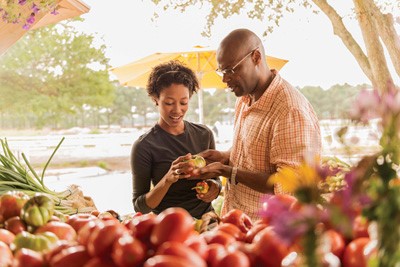Although good nutrition is essential for human life, food production has a significant impact on the environment. Taking a more sustainable approach to sustaining your body can help protect the Earth and its climate.
Food production accounts for more than one-fourth of all greenhouse gas emissions, according to a report compiled by “Our World in Data.” Learn how you can fill your plate with more earth-friendly foods by practicing these sustainable habits:
Grow Your Own Food
Gardening offers many benefits beyond the bounty of your harvest. Spending time outdoors in the sunshine is good for the soul while the foods you raise provide a convenient source of nutrition. Picking fresh produce from your backyard means you’re bypassing transportation, packaging and many of the other aspects of food production that are detrimental to the environment. What’s more, you get to enjoy the satisfaction of knowing you’re personally responsible for the food on your plate.
Reduce Food Waste
An estimated 30-40% of the United States’ food supply goes to waste each year, according to the U.S. Department of Agriculture (USDA). Not only could this food be helping hungry people, it’s taking up valuable space. USDA data shows food waste is the single largest category of material in U.S. landfills.
There are numerous easy ways you can do your part to ensure food is being used wisely. Be sure food is stored properly to prevent it from going bad before you eat it. At the grocery store, select “ugly” foods that may be misshapen or look unusual but are still fully edible. Plan your meals so you use ingredients (across multiple meals, if necessary) and either avoid leftovers or repurpose them into another meal. Avoid overeating, which has a negative impact on your health, wastes food resources and increases environmental impacts from processing and transportation.
Buy Climate-Friendly Foods
Choosing snacks that share your commitment to the climate can make a big difference. Not only does it help you feel better about the foods you eat, supporting brands that make the environment a priority can raise the bar for others. One example is Airly crackers, which are made with 100% wholesome oats and grains, and grown through a farming process that removes carbon dioxide from the air. The company also invests in agricultural and forestry projects by purchasing carbon credits to offset its production and transportation footprint.
The carbon footprint is on the back of each box, so you can see how many grams of carbon dioxide you are helping to remove from the air while satisfying a snack craving. Look for four flavor varieties packed with sweet and savory notes including cheddar, sea salt, chocolate and salted caramel.
Be Conscious of Processing and Packaging
In general, foods with more packaging have a bigger impact on the environment. While some degree of packaging is necessary to safely preserve and transport food, choosing options with minimal recyclable packaging is a step you can take to help reduce how the food you eat affects the Earth.
Know Where it Comes From
Locally produced foods travel a shorter distance, which means they require less handling and transportation. That’s good news for the environment and it’s a simple way to support your community, too. Knowing more about the sources of your food goes beyond eating local. You can also make purchases from brands that promote sustainable agriculture and take meaningful steps to protect the environment, animals and natural habitats.
Learn more about foods that make a difference at airlyfoods.com.
Story & Photo Courtesy of airlyfoods/Family Features



































